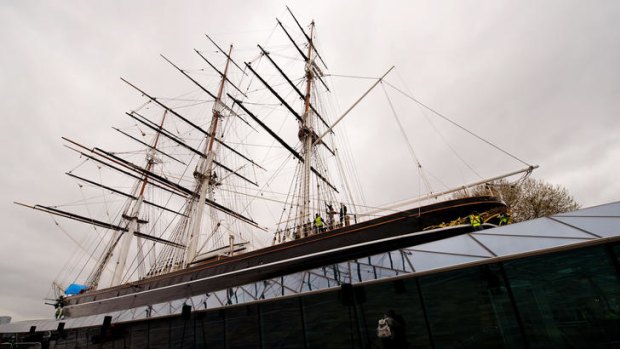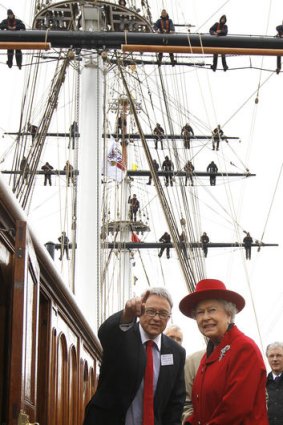
The Cutty Sark in Greenwich, east London has reopened after a major fire forced it to be closed for five years.Credit: AFP
Five years after the Cutty Sark, once the pride of the British Empire, was ravaged by fire the ship has been restored to her former glory in time for a momentous year in Britain.
The 19th century sailing ship was to be re-opened on Wednesday by Queen Elizabeth II, weeks before the monarch celebrates her diamond jubilee in June.
Cutty Sark, which used to streak across the oceans carrying tea and wool, has come a long way since the flames burned through all three of her decks, turning her into an inferno early one morning in May 2007.

Queen Elizabeth II walks on deck with Richard Doughty, director of the Cutty Sark Trust.Credit: AFP
A £50 million ($A78 million) restoration project means the black and white ship's three masts once again dominate the skyline of Greenwich, south London, where she has stood since 1954.
Chris Nash, the architect who oversaw the project, said it was fortunate that the fire struck when an original phase of restoration work, for severe corrosion, had already begun.
"The fire caused a great deal of damage but luckily at the time the important historic parts of the ship had already been taken off and were in storage. That was good luck," he told AFP.
"About five or 10 percent of the ship was lost in the fire, so there was a great deal of luck."
The restoration, described by the Royal Museums in Greenwich as "one of the most complex conservation projects ever undertaken on a historic ship", has been funded by £25 million of public funds raised from Britain's national lottery.
There is great pride that the work has been completed in time not only for the diamond jubilee but also for the London Olympics, which open on the other side of the River Thames from Greenwich on July 27.
In a complex feat of engineering, the ship has been raised three metres (11 feet) in the air, allowing visitors to walk underneath her hull and giving the impression that she is sitting in a sea of glass.
"A lot of ships are conserved and repaired but none have been physically lifted and suspended three metres in the air," said Jim Solomon, the chief engineer. "Projects like this don't come around very often."
Cutty Sark's new elevated position allows visitors to see the innovative design of the hull which enabled her to sail from Sydney to London in 1885 in a then-record 73 days, leaving the early steam ships in her wake.
"It is very important to keep this unique ship to represent the background to our wealth and prosperity," said Nash.
He compares the technological sophistication of Cutty Sark in its time to the impact made by the supersonic Concorde jet in its era.
"This ship is a symbol of British maritime power for many reasons: one is the aspect of trade, the other thing is the technology. At her time this was the most advanced technology that existed."
Solomon said the old ship now has to start to pay her own way.
"In order for this project to be successful... you needed to have a robust business plan.
"If you put her in the water, how would she bring a sufficient income? This is not a ship now, it's a static museum, and it has to be financially viable."
When she was finally rendered obsolete by steamers, it was not all plain sailing for the Cutty Sark before she became a tourist attraction that attracted 16 million visitors until she was closed to the public in 2006.
Built and launched in Dumbarton in Scotland in 1869, the clipper visited most of the major ports in the world, making her name transporting tea from China but also carrying everything from whisky to bison horns.
In 1895, she was sold to a Portuguese firm and renamed the Ferreira, but 21 years later she lost her masts in a storm and was re-rigged as a barquentine.
She was purchased and brought back to England by British seaman Wilfred Dowman in 1922, first going on display in Falmouth before eventually being brought to Greenwich in 1954.
AFP
Sign up for the Traveller Deals newsletter
Get exclusive travel deals delivered straight to your inbox. Sign up now.